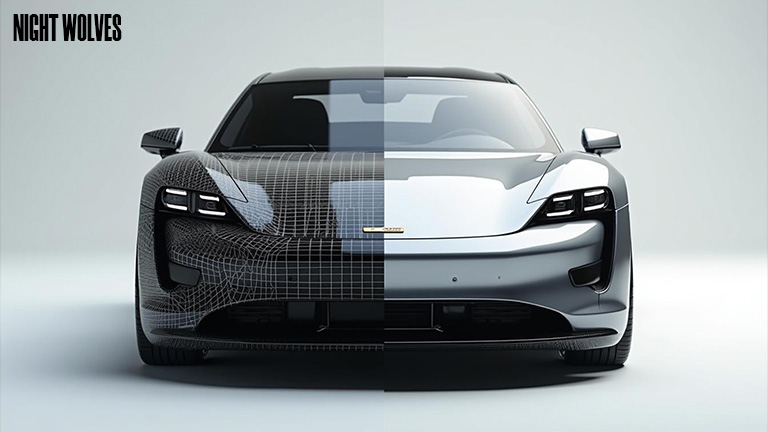In 2025, the debate between CGI (Computer-Generated Imagery) and traditional photography continues to shape visual content creation. Both methods offer unique advantages and limitations, making the choice dependent on project requirements. Understanding the pros and cons of each can help businesses make informed decisions, especially when leveraging CGI services for product photography, marketing, or advertising.
What is CGI and Traditional Photography?
- CGI Services: CGI involves creating photorealistic images using 3D computer graphics software. It offers exceptional flexibility, allowing businesses to design virtual environments and manipulate elements like lighting, angles, and textures with precision.
- Traditional Photography: This method captures real-life moments using cameras in physical settings. It has been a staple for creating authentic visuals for decades.
Pros of CGI Services
- Cost Efficiency
- CGI eliminates the need for expensive location shoots, props, and physical setups. Once 3D models are created, they can be reused across projects, saving costs in the long run.
- Consistency
- CGI ensures uniformity across images by controlling variables like lighting and angles digitally. This is particularly useful for large-scale product photography where maintaining consistency across hundreds of images is critical.
- Flexibility
- With CGI services, businesses can easily tweak elements such as colors, shadows, or perspectives without reshooting. This makes it ideal for industries like furniture or architecture where customization is key.
- Future-Proof
- CGI models can be repurposed for advanced technologies like AR (Augmented Reality) and VR (Virtual Reality), enabling immersive consumer experiences.
- Time Efficiency
- CGI allows faster turnaround times compared to traditional photography, especially for complex projects requiring multiple iterations.
Cons of CGI Services
- Initial Investment
- Creating 3D models requires skilled professionals and specialized software, which can be expensive upfront.
- Learning Curve
- Businesses new to CGI may face challenges in mastering the technology or finding experienced artists.
- Realism Limitations
- While CGI can mimic reality effectively, certain nuances like depth of field or natural imperfections may require extensive post-production to achieve authenticity.
Pros of Traditional Photography
- Authenticity
- Capturing real-life moments provides a sense of tangibility that resonates with audiences. It is particularly effective for human subjects or food photography where realism is essential.
- Ease of Execution
- Traditional photography allows quick changes during shoots without requiring extensive planning upfront.
- Natural Depth and Texture
- Photography inherently captures subtle details like depth of field and texture variations that may be challenging to replicate in CGI.
Have a concept in mind? Let’s turn it into reality with our expert services.
Cons of Traditional Photography
- Costly Logistics
- Location rentals, props, equipment, and professional photographers can make traditional shoots expensive.
- Inconsistent Results
- Environmental factors like lighting or weather can impact image quality, making it hard to maintain consistency across projects.
- Limited Customization
- Adjusting elements post-shoot is often constrained compared to the flexibility offered by CGI services.
Which Method Should You Choose?
The decision between CGI services and traditional photography depends on your industry needs:
| Industry/Project | Recommended Method |
| Consumer Electronics | CGI |
| Furniture | CGI |
| Human Faces/People | Traditional Photography |
| Home Decor | CGI |
| Architecture | CGI |
| Fashion & Cosmetics | Traditional Photography |
| Food | Traditional Photography |
| Jewelry | Traditional Photography |
Conclusion
Both CGI services and traditional photography have their place in modern visual content creation. While CGI offers unmatched flexibility, cost-efficiency, and scalability for industries leveraging digital innovation, traditional photography excels in authenticity and capturing real-life nuances.
For businesses aiming to stay ahead in 2025’s competitive market, combining both methods strategically can yield the best results—leveraging CGI for product images while using traditional photography for lifestyle shots or human-centric campaigns.
Investing in professional CGI services ensures your brand remains future-ready while delivering visually stunning content that engages your audience effectively.
People Also Ask
Q: What is the difference between CGI and traditional photography in product marketing?
Ans: CGI creates images digitally using 3D models, offering flexibility and scalability, while traditional photography involves capturing real objects with cameras, offering authenticity and natural textures.
Q: Is CGI more cost-effective than traditional photography in 2025?
Ans: Yes, while CGI has higher initial costs, it becomes more cost-effective over time due to reusability, faster turnaround, and fewer logistical expenses like location or props.
Q: Which industries benefit most from CGI over traditional photography?
Ans: Industries like automobile, sports, film industry, furniture, electronics, architecture, and home decor benefit from CGI due to its ability to produce scalable, customizable, and photorealistic visuals without physical constraints.
Q: Can CGI achieve the same realism as traditional photography?
Ans: CGI can closely mimic real photography, especially with advancements in rendering technology, though achieving natural imperfections and human realism may require expert-level post-production.
Q: Should businesses use both CGI and traditional photography together?
Ans: Yes, a hybrid approach works best—CGI for product visuals and scalable content, and traditional photography for lifestyle imagery or campaigns involving people, food, or fashion.

